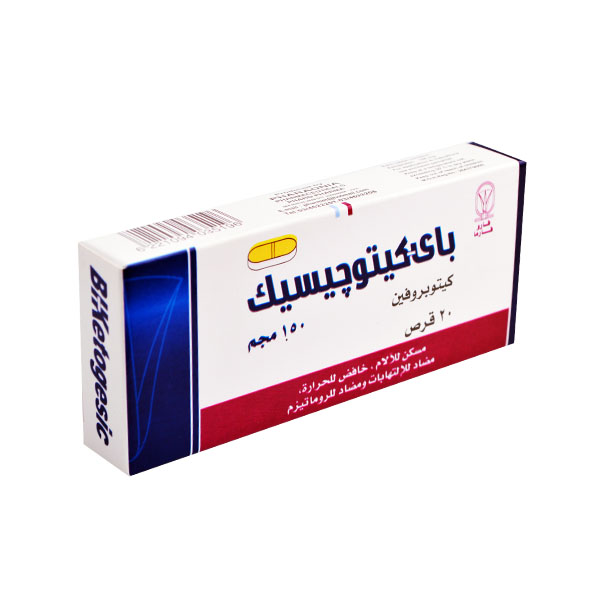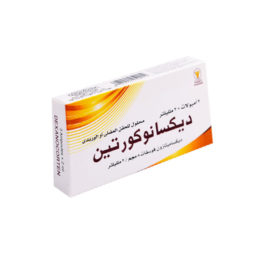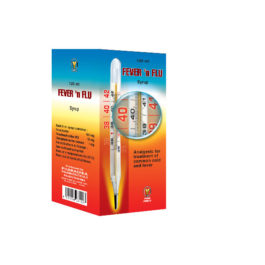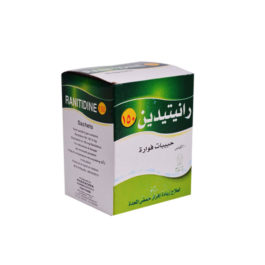Description
PHARMACEUTICAL DOSAGE FORM:
Scored bitablets formed of a white immediate release layer and a yellow sustained release layer.
PHARMACOLOGICAL ACTION:
Ketoprofen is a non-steroidal anti-inflammatory arylcarboxylic acid derivative belonging to the propionic acid group of NSAIDs. Ketoprofen has anti-inflammatory, antipyretic properties and has central and peripheral analgesic activity. It inhibits prostaglandin synthetase and platelet aggregation.
PHARMACOKINETICS:
Ketoprofen is rapidly and completely absorbed from gastrointestinal tract.
The content of the white layer is absorbed quickly, the maximum serum concentration occurs after 1.21 0.88 hours with a plasma concentration of 7.72 1.6 mg. The release of the yellow layer overlaps with the white layer but is slower.
Plasma concentrations show a plateau from minute 45 to minute 90.
When ketoprofen is administered with food, the rate of absorption is slowed but the total bioavailability is not altered.
Ketoprofen is 99% bound to plasma protein.
Ketoprofen crosses the blood brain barrier and the placenta barrier, it is distributed in the synovial fluid and intraarticular tissues, capsule, synovium and tendons.
The elimination half-life in plasma is short, with an average of 3.6 hours.
50% of the administered dose is excreted in the urine within 6 hours following administration.
Approximately 75% to 90% of the dose is mainly excreted in the urine.
INDICATIONS:
Long duration symptomatic treatment:
– Rheumatoid arthritis.
– Painful arthrosis.
Short duration symptomatic treatment of acute pain:
– Musculoskeletal and joint disorders such as tendinitis, sprain.
– Osteoarhritis.
– Acute articular and per-articular disorders.
– Low back pain.
– Acute gout.
– Treatment of migraine.
– Pain such as dental pain, headache and primary dysmenorrhea.
DOSAGE:
Anti-inflammatory dosage:
– Long duration symptomatic treatment:
150 mg / day
– Short duration symptomatic treatment of acute pain:
300 mg / day
Management of migraine crisis:
75 to 300 mg / day.
N.B.: A second dose of Ketoprofen (75 mg to 150 mg) should not be taken during the same migraine crisis, a time interval of 12 hours must be considered between doses.
In case of elderly or impaired renal function:
It is advisable to reduce the initial dosage and maintain such patients on the minimal effective dose.
CONTRAINDICATIONS:
Hypersensitivity to ketoprofen or any of the components.
Gastrointestinal or peptic ulcers.
Impaired renal, hepatic or cardiac function.
Gastro-intestinal hemorrhage, cerebrovascular hemorrhage or any other type of hemorrhage
SIDE EFFECTS:
Gastrointestinal troubles, gastritis, Stomatitis, peptic ulcer, gastrointestinal bleeding, hypersensitivity reactions as rash, erythema, pruritis, urticaria and angioedema, photosensitivity, headache, drowsiness, dizziness, mood disorders, blurred vision, tinnitus, abnormal renal function, nephrotic syndrome, thrombocytopenia, anemia, agranulocytosis, elevation of transaminases concentrations, hypertension, vasodilation, asthmatic attacks, bronchospasms, edema, weight gain, and altered taste.
DRUG INTERACTIONS:
Treatment with NSAIDs should not be associated with any medication favouring hyperkalemia.
Oral anticogulants and heparin should not be taken with NSAIDs.
Concomitant administration of other NSAIDs increase the risk of gastrointestinal ulceration and bleeding.
A time interval of 12 hours between treatment with ketoprofen and methotrexate is necessary.
NSAIDs reduce the antihypertensive effect of Beta blockers, angiotensin converting enzyme inhibitors and diuretics.
Lithium dosage levels should be adjusted during and after NSAID therapy.
NSAIDs should not be used for 8-12 days after mifepristone administration.
Concomitant use of other protein binding drugs as anticoagulants, sulphonamides, hydantoins might necessitate modification of dosage.
Interactions between NSAIDs and other medications as cardiac glycosides, cyclosporins, corticosteroids and quinolones may occur.
PREGNANCY & LACTATION:
As the safety of ketoprofen in pregnancy has not been evaluated, the use of ketoprofen during the first and second trimester of pregnancy should be avoided.
Ketoprofen is contraindicated during the last trimester of pregnancy.
Ketoprofen is not recommended in nursing mothers.
WARNING & PRECAUTIONS:
Cardiovascular Risk
NSAIDs may cause an increased risk of serious cardiovascular thrombotic events, myocardial infarction, and stroke, which can be fatal. This risk may increase with duration of use. Patients with cardiovascular disease or risk factors for cardiovascular disease may be at greater risk. NSAIDs are contraindicated for the treatment of peri-operative pain in the setting of coronary artery bypass graft (CABG) surgery.
Gastrointestinal Risk
NSAIDs cause an increased risk of serious gastrointestinal adverse events including inflammation, bleeding, ulceration, and perforation of the stomach or intestines, which can be fatal. These events can occur at any time during use and without warning symptoms. Elderly patients are at greater risk for serious gastrointestinal events.
In case of patients suffering from allergy to aspirin or any NSAID, this medication may cause allergy.
Patients with asthma are at greater risk than the general population of allergic reactions when taking NSAIDs such as ketoprofen.
As other NSAIDs, in presence of an infectious disease should be noted that ketoprofen may mask usual signs of progression of infection including fever and inflammation.
Caution is required in case of patients suffering from bronchial asthma, uncontrolled hypertension, congestive heart failure, peripheral arterial disease and/or cerebrovascular disease, cirrhosis, renal disease or abnormal liver function.
Monitoring of haematological and biochemical liver and renal function during prolonged treatment.
If there are visual disturbances such as blurred vision treatment should be discontinued.
PACKING:
A carton box containing 2 Aluminium/Transparent yellow orange PVC strips, each of 10 tablets and an inner leaflet.
STORAGE:
Keep at a temperature not exceeding 30C, in dry place.
Keep out of reach of children.
INSTRUCTION TO PATIENTS:
The medication must be taken with liquid, preferably with food.
In migraine crisis, it is recommended that BI-KETOGESIC 150 mg be taken at the onset of symptoms.
SHELF LIFE:
3 years







Reviews
There are no reviews yet.